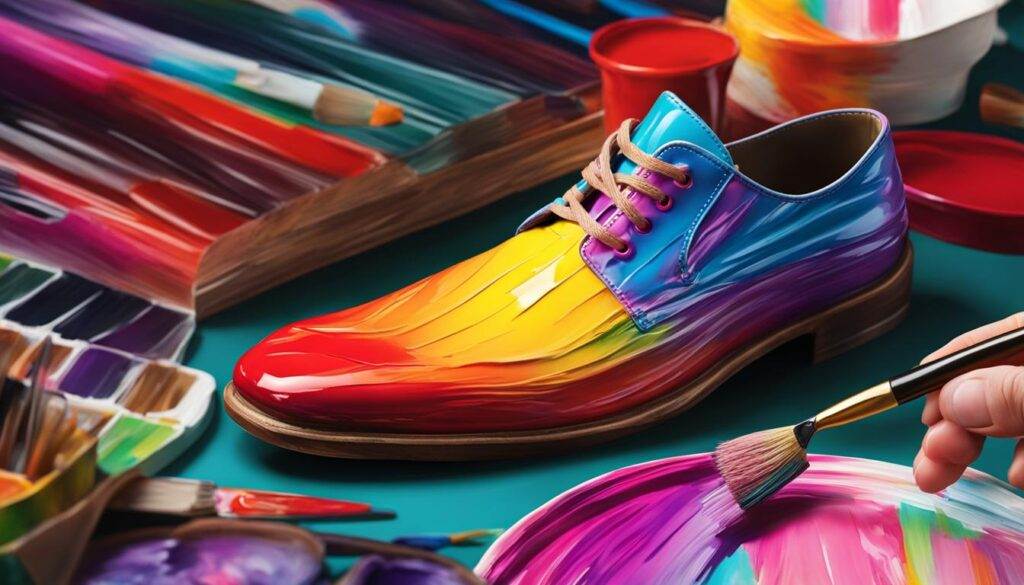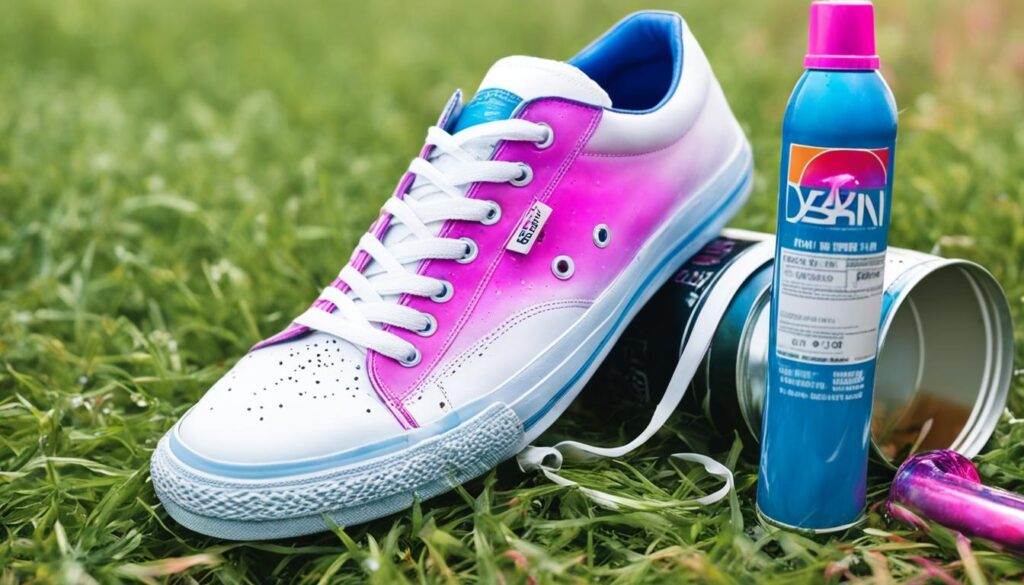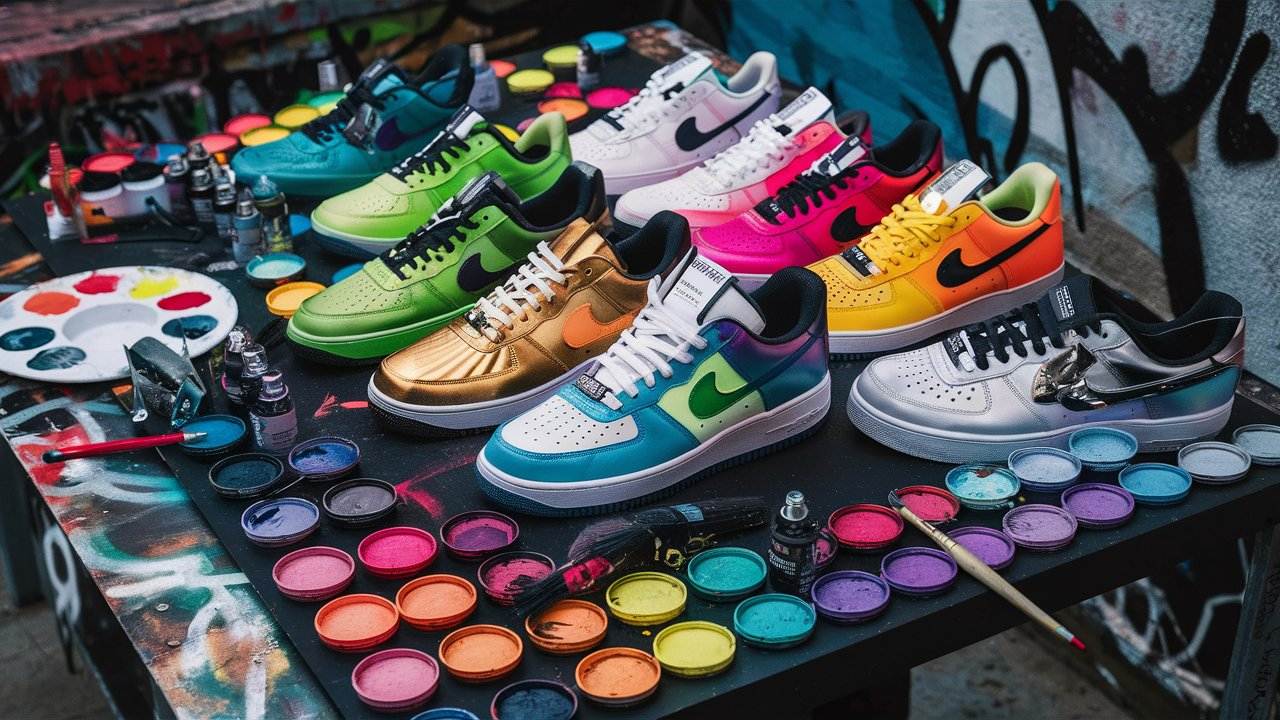To achieve stunning shoe customization, consider using acrylic paints for bold designs and fabric paints for more flexible and wearable art. Whether you’re painting leather, synthetic, canvas, or cloth shoes, these options ensure fantastic results.
Why Customize Your Shoes with Paint?
Customizing your shoes with paint is a super fun way to show off who you are! If you have an old pair that needs some love or want to create something totally new, painted shoes let you express yourself in a way that store-bought shoes just can’t. You can pick from tons of styles and colors to turn plain shoes into cool art pieces that really reflect your vibe.
Plus, customizing your shoes can save you money. Instead of buying new ones, why not give your old kicks a fresh look with some paint? This not only helps your wallet but is also good for the planet because it cuts down on waste and encourages reusing materials.
Custom-painted shoes also make awesome gifts! You can design them based on what the person likes, making them special keepsakes. In today’s world, being eco-friendly in fashion matters. By fixing up worn-out shoes instead of tossing them out, you’re helping reduce waste while showing off your creativity.
Best Types of Paint for Shoe Customization
When you’re ready to paint your shoes, picking the right kind of paint is key for getting great results. Here’s a look at some of the best options:
Acrylic Paint- The Versatile Choice
Acrylic paints are popular because they’re tough and come in lots of colors. They’re easy to use but remember to seal them well on flexible surfaces so they don’t crack over time.
Fabric Paint- Perfect for Canvas and Cloth Shoes
Fabric paints work best on canvas or cloth since they stay flexible after drying. They might not have as many colors as acrylics, but they wash well and are great for everyday wear.
Leather Paint- Ideal for Leather Shoes
Leather-specific paints stick really well and last long on leather surfaces. Just be careful not to use these on other types of materials since they’re made just for leather.
Spray Paint- Quick and Even Coverage
Spray paints are fast and cover large areas easily, which is perfect for quick projects. Just make sure to mask off areas you don’t want painted so everything looks neat!
Paint Markers- Precision and Detailing
If you’re going for detailed designs or fine lines on your customized shoes, paint markers give you great control even though they cover less area than brushes or sprays.
Choosing the right type makes sure that your customizations last longer while keeping their bright colors looking fresh!
Acrylic Paint on Different Types of Shoes
Acrylic paint can work well on many types of shoes; however, how you use it depends on the material:
- Sneakers: Acrylics stick nicely but may crack if not sealed properly after painting.
- Leather Shoes: For leather surfaces, prep like sanding is super important for better sticking.
- Canvas Shoes: Acrylics bond really well; just let each layer dry fully before adding more.
- Vinyl Shoes: Vinyl needs special primers or sealants because its smooth surface can be tricky.
Knowing these tips helps you get better results when customizing different kinds of footwear with acrylic paints!
Essential Tools for Painting Shoes
To customize your footwear with paint successfully, you’ll need some important tools:
- Brushes and Sponges: Different brush types help create various effects; flat brushes are good for big strokes while detail brushes work great for tiny designs.
- Tape: Masking tape keeps areas safe from paint splatters like soles or linings.
- Sealants: These protect your artwork from getting damaged while keeping it safe from water too.
- Pencils and Stencils: They’re handy for sketching out designs before painting; stencils help keep shapes consistent across projects.
Gathering these tools will set you up perfectly before jumping into your customization adventure!
Preparing Shoes for Painting
To get the best results when painting your shoes, preparation is super important. First, start by cleaning your shoes really well. You want to get rid of dirt and oils that might stop the paint from sticking. Use a damp cloth or some mild soap and water, then make sure the shoes are completely dry before moving on.
If your shoes are made of leather, you can try sanding the surface lightly. This helps the paint stick better because it makes the surface a little rougher. After you sand, be sure to wipe off any dust so it’s nice and clean.
Next up is applying a base coat. This is like a blank canvas for your colors! Choose a color that goes well with what you have in mind or use white to make other colors stand out more. Also, don’t forget to cover parts like the inside and sole of your shoes with tape to keep them safe from any paint splatters.
Designing Your Custom Shoes
Now that your shoes are ready, let’s get creative! Start by brainstorming design ideas. Think about themes like nature, abstract art, or even symbols that mean something special to you. You can find cool inspiration from social media or local art galleries.
After you have some ideas, it’s time to sketch your design. You can do this on paper first or directly on the shoe with a pencil. This helps you see how everything will look together! If you’re feeling nervous about painting right away, practice on old shoes first until you feel comfortable.
Step-by-Step Guide to Painting Shoes
When painting your shoes, remember that applying paint in layers is key for a smooth finish. Start with thin coats of paint; this way, you avoid drips and uneven spots. Let each layer dry fully before adding another one—being patient here really helps!
Once you’ve got those base colors down and dried nicely between layers, it’s time for some fun detailing! You can use markers or fine brushes for this part. It’s where you add all those cool little designs that make your custom shoes unique!
Tips for Achieving Professional Results
Want your painted shoes to look pro? Here are some tips! First off, blend colors carefully so they mix smoothly without harsh lines between shades. If something goes wrong—like a smudge or drip—don’t worry! You can fix many mistakes by scraping off extra paint gently after it dries or using fabric paint correctors.
Lastly, sealing the paints is super important for making them last longer and protecting against water damage. Make sure all layers are completely dry before using a sealant; this keeps your artwork looking bright and fresh over time!

Maintenance and Care for Painted Shoes
Keeping your custom-painted shoes looking fresh is super important! A regular cleaning routine helps maintain the vibrant colors of your artwork. Start by using a gentle soap solution with a soft cloth or sponge. This method removes dirt and grime without damaging the paint. Avoid harsh chemicals, as they can strip away the finish and ruin your designs.
Touch-ups are part of painted shoe maintenance too. Over time, you might see minor chips or faded areas. To fix shoe paint in these spots, it’s helpful to have some leftover paint from your original project. Just apply matching paint to those areas for quick fixes that keep your shoes looking sharp.
Re-sealing your painted shoes every few months is another key step in keeping them looking good. A high-quality waterproof coating designed for painted surfaces will protect against wear and tear while preserving those bright colors.
Common Issues and Troubleshooting
Even with proper care, you might face some common issues with painted shoes. Cracking paint can happen if you use the wrong type of paint or don’t seal properly. To prevent this issue, always choose non-cracking paints that are suitable for footwear.
Fading colors can make your designs look dull over time. If you notice this happening, think about rejuvenating vibrancy by reapplying a layer of fabric or acrylic paint as needed. Long-lasting shoe paint options can help keep those eye-catching hues.
Peeling paint often happens because of poor adhesion between layers or on certain materials like vinyl. To minimize this risk, make sure to prepare surfaces correctly before painting and use flexible paints made just for footwear.
Real-Life Stories of Custom Shoe Artistry
Hearing from artists who specialize in custom shoe painting gives great insights into techniques and materials that work best. Many artists recommend quality paints like Angelus leather paints or Fevicryl fabric options due to their durability and rich colors.
Customer reviews also help understand which types of paints perform best across different materials such as canvas sneakers or leather boots. Feedback often shows which brands offer better flexibility and resistance to wear over time, helping others make smart choices when customizing their own shoes.

Expert Advice for Aspiring Shoe Artists
Getting started in custom shoe art can be both fun and a bit scary. Here are some helpful tips from experienced artists to help you along the way.
First, pick the right type of paint for your project. If you’re painting sneakers, acrylic paint works great. For dress shoes, leather paint is the way to go. Knowing how each type of paint behaves will make a big difference in how your shoes turn out. Always try your paints on a small area or an old pair of shoes first to see how they stick and dry.
When you start designing, think about what reflects your style or what’s popular right now. Check out cool designs on social media platforms like Instagram and Pinterest for ideas. Sketching your design before you start painting can help you see what it will look like and let you make changes if needed.
Practice makes perfect when it comes to artistic shoe customization. Begin with simple designs on less valuable shoes to build your confidence before tackling more complex projects. This lets you play around with different methods—like layering colors or blending—to get professional results.
Watch out for common mistakes! A lot of beginners forget to prep their shoes properly or rush drying times between layers. Make sure to clean your shoes well and let them dry completely before starting. Using multiple thin layers instead of one thick layer will give better adhesion and a smoother finish.
Finally, don’t shy away from getting feedback from other artists or online communities focused on shoe customization. Talking with others can give you fresh ideas and techniques that improve your skills in custom shoe painting.
Latest Trends in Shoe Customization
The world of custom shoe art is always changing, with new trends popping up all the time. One big trend is using bold colors and detailed patterns that really stand out. Many artists are trying out neon shades or shiny metallic finishes that add a unique touch to their work.
Another trend is sustainability; lots of artists are giving new life to old shoes instead of making brand-new ones from scratch. This eco-friendly choice not only cuts down on waste but also allows for creative expression by turning worn-out footwear into special pieces.
Social media is key in shaping these trends too! Platforms like TikTok show quick tutorials that inspire new artists to customize their own footwear. Collaborations between well-known brands and independent artists have also become popular, leading to limited-edition collections that mix mainstream fashion with unique artistry.
Predictions for the Future of Custom Shoe Art
Looking ahead, the future of custom shoe art seems bright with several exciting predictions shaping its path. More people are embracing personalized footwear as a way to express themselves rather than just wear functional items.
We can expect innovative materials like eco-friendly paints and flexible fabrics made specifically for customization becoming more common in stores soon. These advancements will give artists more freedom in their designs while encouraging sustainable practices within the industry.
Also, partnerships between local artisans and bigger brands could lead to unique collections that attract different audiences looking for individuality in their fashion choices. This could create chances for aspiring artists while boosting bespoke designs into high-demand products.
Embracing these trends while practicing will help aspiring shoe artists make meaningful contributions to this lively community—turning every pair into not just clothing but an artistic statement showing off personal style!

